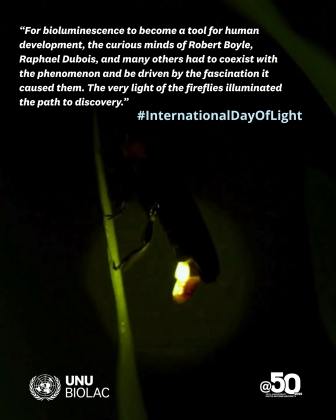Light is the bringer of life. The tiny spectrum of electromagnetic radiation that spans visible light is life's vehicle of choice to transport the energy it needs from the sun. As animals with eyes, we can even see the wonders it creates thanks to it. Our relationship with light is exciting and awesome, and we are suddenly reminded of our love for light when there is an unexpected source over a vast obscurity: A clear starry sky, a Christmas-lit street, or a swarm of fireflies breaking the night.
Bioluminiscence is the phenomenon by which these insects perform their spectacle. It is a biological of an enzyme called luciferase that oxidizes its substrate, luciferine, emitting photons in the process. The enzyme-substrate pair was discovered by Raphael Dubois at the end of the 19th century. There is a different luciferase-luciferine system for each light-emitting species of insect, fungi, bacteria, sea animal, and protozoa. Humans have been watching their displays since we appeared on this planet, probably wondering what it means.
The answer to this question led humanity to eventually harness bioluminiscent proteins to advance biological research in-vivo, in-vitro, and in-cellulo, solving fundamental problems like measuring the concentration of metabolites, biological parameters, gene expression, and protein interactions, and studying cell transportation/secretion mechanisms in real time. Bioluminiscence is a regular tool for drug discovery, food safety screening, contamination monitoring, disease diagnostics, and agricultural research. It has even been used as a targeted light source for phototherapy against photosensitized tumors.
Different applications come from different luciferase-luciferine systems, because they have different properties like light wavelength, optimal conditions, and cellular mechanisms. At this point, it's easy to understand how this fundamental biotechnological tool comes from nature. Moreover, its versatility is a product of the vast biodiversity of light-emitting organisms.
This is why we want to preserve biodiversity. Clearly, without those genes, we would obviously not have been able to use bioluminescence. But the effect of conservation goes beyond the existence of the gene: Think of how many breathtaking firefly and copepod summer shows Robert Boyle, the father of modern chemistry, got to watch during his childhood and adolescence in 17th Century Britain and Italy, before deciding to pursue the first recorded scientific studies on the subject of bioluminiscence.
Before hypotheses, there have to be observations. And it is challenging to observe solutions in nature if they are limited to a few small pouches and sanctuaries. For bioluminiscence to become a tool for human development, the curious mind of Boyle, Raphael Dubois, and many others had to coexist with the phenomenon and be driven by the fascination it caused them. The very light of the fireflies illuminated the path to discovery.
The decline of firefly populations is a quite visible empirical measurement of the biodiversity crisis that we are going through. Habitat loss, light pollution, and pesticides are the most likely culprits for the fact that most kids today have never seen a proper swarm lighting up the night. Lucky for us, we already know, use, and can synthesize light-emitting proteins. But, do we dare to imagine how many other miracle genes were lost before someone got to see them? Will we be able to preserve what is left?
Suggested citation: Peláez Carlos., "Guided by the light," UNU-BIOLAC (blog), 2025-05-16, 2025, https://unu.edu/biolac/blog-post/guided-light.

